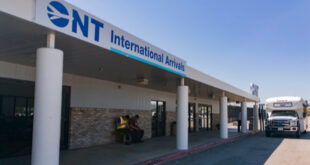The question is, how well do they pay? It’s proponents say logistics is a gateway to the middle class for people who don’t have a lot of education, but a recent UC Riverside study says the pay numbers claims are misleading.
One of the key selling points of the World Logistics Center in Moreno Valley has been the number of well-paying jobs the project will bring to city.
Developer Iddo Benzeevi and the development’s supporters have constantly stressed the estimated 20,000 jobs the facility will create over a 30-year build-out, and that some of those jobs would pay six-figure salaries.
Their sales pitch worked. The city council on Wednesday approved the project following a marathon public hearing held on three consecutive nights. With partisan rancor and frequent insults coming from both sides, the council opted for jobs over multiple environmental concerns.
Benzeevi has already built several large warehouse-distribution operations in around Moreno Valley, including the Skechers on Eucalyptus Ave. south of the 60 Freeway, but the World Logistics Center is by far his most ambitious development.
When finished, the 40.6-million-square-foot project on Moreno Valley’s east side will be large enough to cover about 700 football fields, making it one of the largest industrial developments of its kind in the United States, if not the world.
In pleading his case before the planning commission and then the city council, Benzeevi has promoted logistics as the “new manufacturing” because of the amount of high-paying jobs that sector has the potential to create.
He’s not alone in that view.
Inland economist John Husing has long promoted bringing more and more warehouse-distribution development into San Bernardino counties, calling it the best way for Inland residents – about 50 percent of whom have no more than a high school education – to earn their way into the middle class.
“What else are you going to bring in?,” Husing said. “You have construction and manufacturing, but construction is only now starting to come back and there isn’t much manufacturing coming into California because the state is so heavily regulated. Nothing else pays as well as logistics, and you can move up once you get into it.”
That may not be true, says a small group of researchers at UC Riverside. They maintain that blue collar jobs in the logistics industry do not pay well as advertised, nor do they give workers adequate medical care much of the time.
In a report released last month – called “Why The City of Ontario Needs to Raise the Minimum Wage: Earnings Among Warehouse Workers in Southern California – a three-person research team found that many logistics jobs in the Inland region are filled by temporary workers provided by staffing agencies.
That automatically eliminates having to pay minimum wage and provide medical benefits, the report noted.
“While warehouses do provide jobs for the region’s workforce, these jobs are not necessarily good jobs,” stated the report, which compared its findings to a similar report conducted recently by the U.S. Bureau of Labor Statistics and the 2009-’13 American Community Survey.
The study, based on 136 surveys of warehouse workers in the Inland Empire conducted during the fall of 2012 and the winter of 2013, found that those workers were paid an average $10.05 an hour, or $16,800 a year.
That’s well below the estimated living wage for the region, which pencils out to $11.59 an hour for a single person with no dependents and $23.90 a hour for one adult with one child, according to the study.
Ontario should do what Los Angeles did recently and raise its minimum wage, a move it said would stimulate the local economy by increasing consumer spending, cutting employee turnover costs and improving workers productivity, the report recommended.
The arguments in the UC Riverside survey were essentially the same as those put forward by opponents of the World Logistics Center from the time Moreno Valley-based Highland Fairview – Benzeevi the company’s president and chief executive officer – first proposed the development three years ago.
“When I heard about that report and what was in it I said ‘damn right,” said Tom Thornsley, a longtime Moreno Valley resident and an opponent of the World Logistics Center. “If you want to learn what people who work in the logistics industry are paid, you need to focus on the people who work in the warehouses.”
Benzeevi counts every sector associated with logistics to create a false impression of how much people in the logistics industry are paid, Thornsley said.
“He even counts longshoremen, and they make a lot of money, but they aren’t working in the warehouses,” Thornsley said. “It’s not an accurate picture.”
During his final remarks on the project before the vote was cast Wednesday, Councilman George Price wondered aloud about how many jobs World Logistics Center would create and what they will actually pay.
“Mr. Benzeevi says he’s going to create 20,000 jobs,” Price said before casting his no vote. “I just hope those will be jobs that pay a livable wage.”
Husing and Benzeevi both dismissed the UC Riverside report, saying it was based exclusively on jobs at the low end of the logistics pay scale.
Like any industry, logistics has its share of high-paying and low-paying jobs, as well as jobs in the middle of the pay scale and temporary positions that can lead to permanent jobs, Benzeevi said.
“Of course some people are going to make more money than others,” said Benzeevi, who said the study was based on interviews with “a few people at the back of the warehouse” who were on the low-end of the pay scale. “That’s inevitable. You can’t have an army with nothing but generals.”
 IE Business Daily Business news for the Inland Empire.
IE Business Daily Business news for the Inland Empire.


